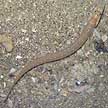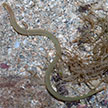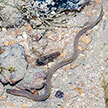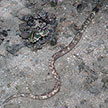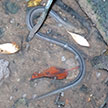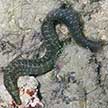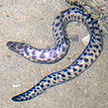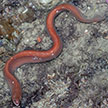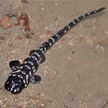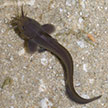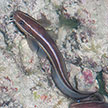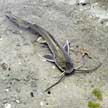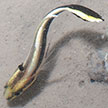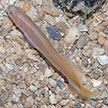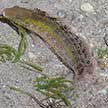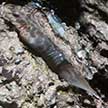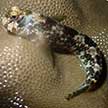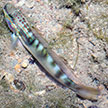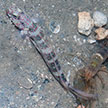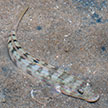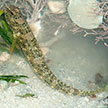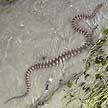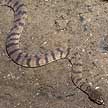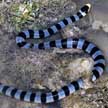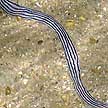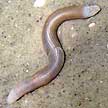|
|
|
|
|
| 8-10cm.
Long slender body, pointed snout. Hides in sandy areas near reefs.
Sometimes seen on our Southern shores. |
10-12cm,
to 20cm. Body long and worm-like. No pectoral or tail fins, no scales.
The tip of the tail is sharp. Small eyes and mouth. Coral rubble,
living reefs. Commonly seen on our Southern shores. |
20-30cm,
to 60cm. Body slender. Bluish grey, brown to reddish-brown with numerous yellowish-white speckles. No pectoral fins, no scales. Coral
rubble, near reefs. Sometimes seen on some of our shores. |
30-40cm.
Body long and snake-like. Small pectoral fins. Sharp tail tip. Small
eyes and mouth. Coral rubble, living reefs. Sometimes seen on our
Southern shores. |
30cm.
Body long and snake-like. Small pectoral fins. harp tail tip. Small
eyes and mouth. Mangroves. |
|
|
|
|
|
| 10-15cm,
to 30cm. Floral markings. Has pectoral fins. Tail is eel-like with
the dorsal, anal and tail fins continuous. Coral rubble. Commonly
seen on many of our shores. |
30cm,
to 60cm. Body thick. Brown with dark brown spots. No pectoral fins, no scales.
Sometimes seen on some undisturbed shores |
To
50cm. Plain brown without spots. No pectoral fins, no scales. Rarely
seen. |
|
Up
to 1m. Various kinds seen on our Southern shores. |
|
|
|
|
|
| 4-5cm,
to 90cm-1.5m. Eel-like tail, plain dusky-brown to black colour with
a black dorsal fin tip and a pale belly. In adults, the long barbels
can reach past the eyes. Near seagrasses. Commonly seen on our Northern
shores. |
2-15cm,
to 90cm-1.5m. Eel-like tail, two or more white lines on dark body.
The lines are faded in old adults. In adults, the long barbels don't
reach past the eyes. Among seagrasses, coral rubble and reefs. Commonly
seen on our Southern shores. |
To
20-30cm. Tail fin forked. 3, rarely 2 pairs of barbels. Not commonly
seen on the intertidal, but sometimes caught by fishermen. |
10cm. Juveniles are yellow with two broad black stripes. Sometimes seen on some of shores. |
|
|
|
|
|
|
| 5-7cm.
Body long flattened with blunt head. Usually orangey pink. Small tail fin separated from long dorsal and anal fins. Coral rubble near seagrasses.
Sometimes seen on some of our shores. |
|
5-7cm.
Body long flattened with blunt head. Among seagrasses. Sometimes seen
on some of our shores. |
5cm.
Body long flattened with blunt head. Among encrusted rocks and sewalls,
surviving even out of water. Sometimes seen on our shores. |
5cm.
Body long flattened with blunt head. Among encrusted rocks and sewalls,
surviving even out of water. Sometimes seen on our shores. |
|
|
|
|
|
| 6-8cm.
Bright and colourful markings especially on the head. Coral rubble
near reefs. Sometimes seen on our shores. |
4-6cm.
6 broad oblique bars on the body, many pink and blue spots on the
head. Lives with a snapping
shrimp. Sandy, silty areas near reefs. Sometimes seen on our Southern
shores. |
6-10cm.
Two bright orange stripes. Near reefs. Sometimes seen on our shores. |
5-7cm.
Adults with 5 or more pale saddles, dark spots along the sides and
speckles all over. Lives with a snapping
shrimp. Sometimes seen on our Southern shores. |
|
| |
|
|
|
|
|
|
|
|
|
|
| 1m
or more. Black or brown bands on white or beige, bands are broad on
the top but narrows at the sides. Near mangroves in seagrass areas.
Sometimes seen on our Northern shores. |
About
1m. Irregular bands of grey, brown or olive on beige. Dark streak
through the bulging eye to the neck. In mangroves. Commonly seen on
our Northern shores, sometimes on our other shores too. |
About
1.4m. Bluish-grey, smooth scales and regularly spaced black bands.
Upper lips yellow, tail flattened into a paddle-like shape. Coral
reefs and rubble. Sometimes seen on our Southern shores. |
Up
to 1m long. Soft bodied, these are worms. |
5-10cm.
Unsegmented worm. Ridges on body like the texture of a peanut shell.
It is a worm. |

